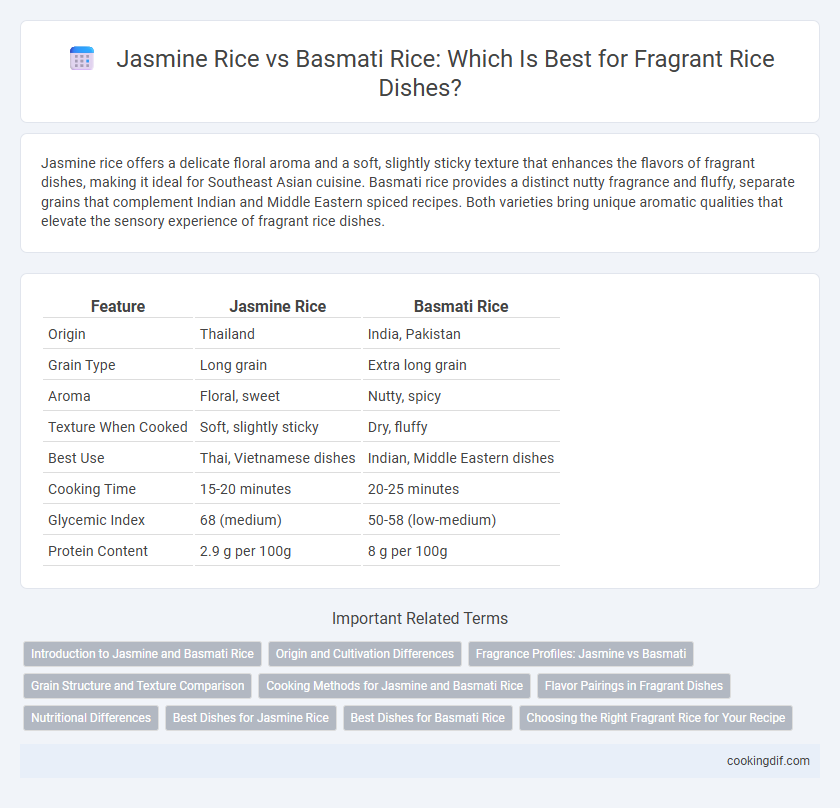Jasmine rice offers a delicate floral aroma and a soft, slightly sticky texture that enhances the flavors of fragrant dishes, making it ideal for Southeast Asian cuisine. Basmati rice provides a distinct nutty fragrance and fluffy, separate grains that complement Indian and Middle Eastern spiced recipes. Both varieties bring unique aromatic qualities that elevate the sensory experience of fragrant rice dishes.
Table of Comparison
| Feature | Jasmine Rice | Basmati Rice |
|---|---|---|
| Origin | Thailand | India, Pakistan |
| Grain Type | Long grain | Extra long grain |
| Aroma | Floral, sweet | Nutty, spicy |
| Texture When Cooked | Soft, slightly sticky | Dry, fluffy |
| Best Use | Thai, Vietnamese dishes | Indian, Middle Eastern dishes |
| Cooking Time | 15-20 minutes | 20-25 minutes |
| Glycemic Index | 68 (medium) | 50-58 (low-medium) |
| Protein Content | 2.9 g per 100g | 8 g per 100g |
Introduction to Jasmine and Basmati Rice
Jasmine rice, predominantly grown in Thailand, is known for its delicate floral aroma and slightly sticky texture, making it ideal for Southeast Asian fragrant dishes. Basmati rice, originating from the Indian subcontinent, features a nutty fragrance and distinct long grains that remain separate when cooked, perfect for Indian and Middle Eastern cuisines. Both varieties enhance dishes with unique aromatic profiles, influencing flavor and texture preferences in global cooking.
Origin and Cultivation Differences
Jasmine rice, primarily cultivated in Thailand, is renowned for its naturally sweet aroma and moist texture, making it ideal for Southeast Asian fragrant dishes. Basmati rice, originating from the Himalayan foothills of India and Pakistan, boasts a distinct nutty fragrance and elongated grains, favored in South Asian cuisine. The cultivation of Jasmine rice thrives in tropical climates with abundant rainfall, while Basmati rice requires a cooler, drier environment with slower maturation, influencing their unique aroma profiles.
Fragrance Profiles: Jasmine vs Basmati
Jasmine rice offers a sweet, floral aroma with hints of pandan, making it ideal for Southeast Asian fragrant dishes that benefit from its subtle fragrance. Basmati rice features a distinctive nutty and slightly spicy scent, prized in Indian and Middle Eastern cuisines for complementing rich, aromatic spices. The choice between Jasmine and Basmati rice depends on the desired fragrance profile, with Jasmine providing a softer, more perfumed aroma and Basmati delivering a robust, toasted fragrance.
Grain Structure and Texture Comparison
Jasmine rice features short to medium grains with a slightly sticky texture when cooked, making it ideal for fragrant dishes that require moisture to absorb flavors. Basmati rice has long, slender grains that remain separate and fluffy, providing a light and airy texture suited for aromatic dishes emphasizing distinct grain integrity. The differing grain structures influence the mouthfeel and presentation, with jasmine rice offering a soft, cohesive bite and basmati giving a drier, more textured finish.
Cooking Methods for Jasmine and Basmati Rice
Jasmine rice requires rinsing and cooking with a precise water-to-rice ratio of 1.5:1 to achieve its soft, sticky texture essential for fragrant dishes, usually steamed or boiled gently to preserve aroma. Basmati rice demands soaking for 30 minutes before cooking, followed by simmering with a 1.75:1 water-to-rice ratio and a gentle fluffing to maintain its long, separate grains and distinct nutty fragrance. Both methods emphasize careful water measurement and heat control to enhance each rice's unique aroma and texture in culinary applications.
Flavor Pairings in Fragrant Dishes
Jasmine rice, with its sweet, floral aroma, pairs exceptionally well with Southeast Asian dishes like Thai curries and stir-fries, enhancing flavors of lemongrass, coconut milk, and ginger. Basmati rice, known for its nutty, aromatic profile, complements Indian and Middle Eastern dishes such as biryanis and pilafs, blending seamlessly with spices like cardamom, cumin, and saffron. Both rices elevate fragrant dishes but suit different regional flavor profiles based on their unique aroma and texture.
Nutritional Differences
Jasmine rice contains slightly more calories and carbohydrates than Basmati rice, making it a richer energy source for fragrant dishes. Basmati rice offers a lower glycemic index, benefiting blood sugar control and making it preferable for diabetic-friendly meals. Both varieties provide minimal fat content, but Basmati rice contains more fiber and protein, enhancing satiety and nutritional value in aromatic cuisine.
Best Dishes for Jasmine Rice
Jasmine rice, known for its subtle floral aroma and slightly sticky texture, pairs perfectly with Southeast Asian dishes like Thai green curry, stir-fries, and coconut milk-based recipes. Its natural fragrance enhances the flavors of dishes such as Pad Thai, mango sticky rice, and Vietnamese lemongrass chicken, making it a popular choice in fragrant, spiced meals. Unlike Basmati rice, which works well in Indian and Middle Eastern cuisines, Jasmine rice excels in recipes that benefit from its moist texture and delicate scent.
Best Dishes for Basmati Rice
Basmati rice excels in fragrant dishes such as biryanis, pilafs, and Indian curries due to its long grains and distinctive nutty aroma that remains separate and fluffy when cooked. Its lower starch content compared to jasmine rice ensures a light, non-sticky texture ideal for layered meals and rich sauces. Traditional recipes like Hyderabadi biryani, Persian pulao, and Arabian machboos showcase the best use of basmati rice's aromatic and tensile qualities.
Choosing the Right Fragrant Rice for Your Recipe
Jasmine rice offers a soft, slightly sticky texture with a floral aroma ideal for Southeast Asian dishes, enhancing flavors without overpowering them. Basmati rice features a long, slender grain with a nutty fragrance and fluffy texture, perfect for Indian and Middle Eastern recipes requiring separate, non-clumpy grains. Selecting between jasmine and basmati rice depends on the desired texture and aromatic profile to complement the specific spices and sauces in your fragrant dish.
Jasmine rice vs Basmati rice for fragrant dishes Infographic

 cookingdif.com
cookingdif.com